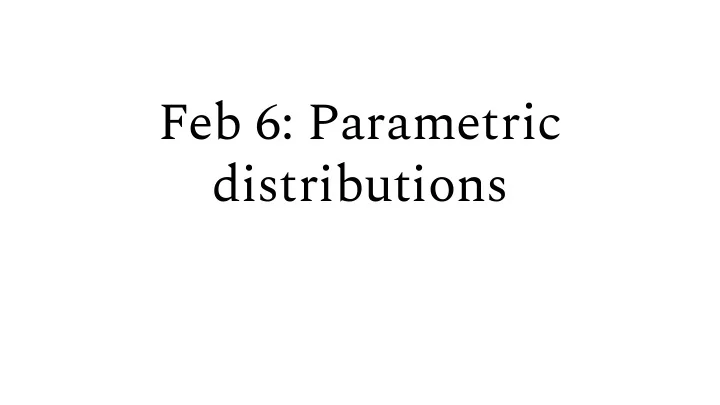

Feb 6: Parametric distributions
What is a notebook anyway? The kernel stores the environment , representing variable names and their values. The notebook server listens for web requests The browser only stores the and passes them to the code input and the output of kernel to execute Python each cell. code in an environment. The notebook .ipynb file stores the same information to disk. https://jupyter.readthedocs.io/en/latest/architecture/how_jupyter_ipython_work.html
Assumptions make math easier One of the most common statistical assumptions about events is that they are 1. Independent (one event tells you nothing about the next) 2. Identically distributed (probability is the same for each event) If events are independent, we can simply multiply their probabilities . If they are iid , we can just find the probability of one event and raise it to an exponent .
Test yourself Which of these event sequences is iid , and which are not? Why? Five players each take one penalty kick ● Number of french fries in 10 servings from the same restaurant ● A bus either does or does not pick up passengers at each stop ●
My answers Which of these event sequences is iid , and which are not? Why? Five players each take one penalty kick ● Independent, but not identically distributed ○ Number of french fries in 10 servings from the same restaurant ● Restaurants try to maintain consistency, probably iid ○ A bus either does or does not pick up passengers at each stop ● Not identical (some stops are popular) and also not independent: if it's raining, all stops will ○ have higher probability, so a person at one stop may imply the presence of people at others All of these are interpretations. You can probably argue convincingly that I'm wrong about any of these. What matters is whether the simplifying assumption is valid enough to make the simpler calculations accurate enough.
We can define a distribution over N events with N-1 numbers Event 1 2 3 4 Probability 0.3 0.1 0.4 ???
We can define a distribution over N events with N-1 numbers Event 1 2 3 4 Probability 0.3 0.1 0.4 ??? This number has to be 0.2, since the probabilities have to add up to exactly 1.0.
Parametric models use functions to assign probability to many events with few parameters The binomial distribution allows you to assign probability to N events using only two numbers. The catch: parametric distributions can only represent certain shapes of distributions. They are efficient in parameters, but inflexible. This is ofuen a good property: see Occam's razor .
Parametric distributions are all-purpose tools Set of possible events Probability function Data generating process "Origin story" Parameters that determine behavior
Bernoulli distribution Origin story: Sample a value 1/0 with some probability p . What is the event space? What are the parameters?
Binomial distribution Origin story: Sample a sequence of n values 1/0 with some probability p , then add. What is the event space? How do we calculate the probability that the sum is 5? What are the parameters? Source: Wikipedia
Recommend
More recommend